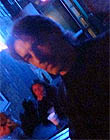|
|
 
|
|
Author
|
Topic: CPC London making film prints
|
|
|
|
|
|
|
|
|
|
|
|
|
|
|
|
|
|
|
Leo Enticknap
Film God

Posts: 7474
From: Loma Linda, CA
Registered: Jul 2000
|
 posted 10-22-2018 07:53 AM
posted 10-22-2018 07:53 AM





Agreed, and I'm wondering what the market for this service essentially is.
The only one I can think of is the small band of projectorsexuals who wax lyrical about the wonders of "celluloid," and believe that anything is better seen on 35mm, regardless of how the footage was originated and post-produced, or the quality of the installation and projectionist presenting it. In other words, the "it's cool if you don't understand it but I think I do" crowd.
By the same token, there has recently been a tsunami of fanboys on the usual online haunts celebrating the relaunch of Ektachrome. I doubt if 99% of them will ever buy a roll, let alone figure out how to do E6 processing (or find somewhere that can still do it for them for less than the price of a second mortgage). No-one gives 35mm slide shows or plays Super 8 home movies on an Elmo anymore, so anyone originating images on film now has to scan them. Why on earth would you use dense, high contrast reversal film, when (for 35mm stills) a $300 scanner will give you pretty impressive results from b/w negative or C41, but you're looking at $2K minimum for something that will reveal even a fraction of the black detail in Kodachrome or Ektachrome?
| IP: Logged
|
|
|
|
|
|
Scott Norwood
Film God

Posts: 8146
From: Boston, MA. USA (1774.21 miles northeast of Dallas)
Registered: Jun 99
|
 posted 10-22-2018 11:35 AM
posted 10-22-2018 11:35 AM





I do slide shows, too. I miss Ektachrome (and Kodachrome). Fuji Provia works OK, but it isn't the same look.
From a larger market perspective, though, the biggest market for reversal is probably for motion-picture film to be used by movies, TV shows, and commercials when they want to achieve a "home movie" look. Modern color negative looks 'too good' for this purpose, even when shot on 16mm or 8mm. Also, architectural photography, if they can get it made in 120 and 4x5" formats.
But, for motion-picture prints, the market seems to me to be mostly made up of the following:
- reprints of older titles originally printed on film (for which printing negatives already exist)
- prints of new titles made by people who value the photochemical process and its unique look (and who wouldn't want a DI)
Neither of these is served by the Cinevator process.
In the past, it would have made sense for exhibition of video material in venues only equipped for 35mm, but the number of people who need that must be pretty close to zero now.
I could see maybe doing it for trailers to be shown in a film program or something like that, though.
Again, I am glad that the service exists, but most of the needs that it fills are probably better filled by other services.
| IP: Logged
|
|
|
|
|
|
All times are Central (GMT -6:00)
|
|
Powered by Infopop Corporation
UBB.classicTM
6.3.1.2
The Film-Tech Forums are designed for various members related to the cinema industry to express their opinions, viewpoints and testimonials on various products, services and events based upon speculation, personal knowledge and factual information through use, therefore all views represented here allow no liability upon the publishers of this web site and the owners of said views assume no liability for any ill will resulting from these postings. The posts made here are for educational as well as entertainment purposes and as such anyone viewing this portion of the website must accept these views as statements of the author of that opinion
and agrees to release the authors from any and all liability.
|

 Home
Home
 Products
Products
 Store
Store
 Forum
Forum
 Warehouse
Warehouse
 Contact Us
Contact Us




 Printer-friendly view of this topic
Printer-friendly view of this topic






![[Big Grin]](biggrin.gif)



![[Wink]](wink.gif)




